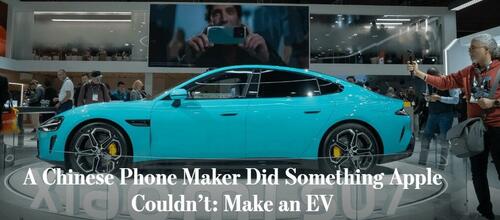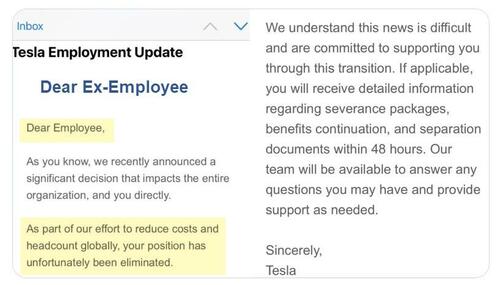Authored by Mike Shedlock via MishTalk.com,
Just three years ago, the Chinese company Xiaomi decided to build cars. It succeeded where Apple failed.
The Wall Street Journal reports A Chinese Phone Maker Did Something Apple Couldn’t: Make an EV
Xiaomi is a Chinese company known for its rice cookers, robot vacuums, air purifiers and smartphones. Now, it has pulled off what Apple, its longtime rival, couldn’t: Make an electric car and bring it to market. And it did it in three years.
In its home market, Xiaomi —pronounced SHAU-mee—is cranking out its SU7 sedan to a waiting list of buyers after its launch in late March. Since early April, the Beijing-based company said it had delivered more than 10,000 of the electric vehicles and received nearly 90,000 binding orders.
Priced between $30,000 and $42,000, the company says the SU7 can go up to 500 miles on one charge, undercutting comparable versions of the Tesla Model 3 in China by around $4,000 and outrunning it by around 200 miles per charge.
Xiaomi’s feat illuminates a new reality in the century-old automotive business: The barriers to entry for making a car have shrunk in recent years with the emergence of electric vehicles. And in this new reality, China is speeding way ahead.
To simplify development and reduce costs, Xiaomi adopted Tesla’s process of “gigacasting,” which employs large-scale, high-pressure aluminum die-casting to create the car’s frame. The process combines hundreds of manufacturing steps into one, saving on components, weight, cost and time.
Xiaomi also had to innovate. The liquid aluminum that gets injected into the die-casting machine has to be a certain variety that can withstand an extraordinary amount of pressure. Xiaomi had to come up with its own material, building an artificial-intelligence program that used a method known as deep learning to simulate how different materials would behave when placed inside the die-cast machine.
The company only seriously started looking into entering the car sector after the U.S. government blacklisted it in January 2021 for what it said were ties to China’s military, prohibiting Americans from investing in Xiaomi.
Xiaomi Profitable When?
Xiaomi loses money on cars. To turn a profit, Xiaomi would have to produce 300,000 to 400,000 of the SU7 each year, Xiaomi CEO Lei Jun told CCTV.
It’s unclear if this company succeeds at building cars. But I suspect it will.
Regardless, Xiaomi has proven a company that makes phones can make cars three years later.
What exactly does Tesla have that some Chinese company can’t do better or cheaper? Perhaps self-driving technology, but there Tesla seriously lags Waymo.
Preparation for Growth
On April 15, I noted Elon Musk Fires 10 Percent of Tesla Workforce, Prepares for “Next Phase of Growth”
Preparing for Growth
Preparing for growth by firing working is like trying to lose weight by stocking the pantry with more potato chips.
On May 6, I noted Another Round of Mass Firings at Tesla, Sales Must Be Imploding
Tesla announced yet another round of layoffs today. News came in the typical way, an email starting “Dear Employee”. It seems “Dear Ex-Employee” would be more fitting.
Tiresome Lies
Musk statements are no longer best viewed as excessive hype, but rather tiresome lies.
For four years running, Musk promised to make 50,000 electric semis. Tesla delivered a grand total of 100.
Carbon Credits
Carbon Credits notes Tesla Hits Record High Sales from Carbon Credits at $1.79B
Elon Musk’s Tesla generated a substantial $1.79 billion from carbon credit sales last year, as revealed in their Q4 2023 and annual financial report, bringing its total earnings from such credits since 2009 to nearly $9 billion.
The revenue generated from the sale of carbon credits has become a substantial source of income for the company. In fact, the credits account for a staggering 11% of Tesla’s overall gross margin for the quarter, $4,065 million, down from 25.9% seen in Q4 2022.
Despite its continued dominance in the U.S. EV market, Tesla faces growing competition, particularly from China’s BYD. The Chinese automaker recently surpassed Tesla as the world’s largest seller of EVs.
Tesla’s Lead Has Vanished
Whatever technology lead Tesla once had is now gone.
Tesla’s Full Self Driving FSD technology is essentially vaporware.
On May 14, I noted BYD Unveils the “Shark” a Plug-in Hybrid Pickup Truck Built in Mexico
The Chinese automaker BYD (Build Your Dreams) announces a 700-mile range PHEV that will be built in Mexico, this year.
Also see Biden Wants EVs so Badly That He Will Quadruple Tariffs on Them
Astute readers will immediately notice the title of this post makes no sense. It’s not supposed to. But it is exactly what President Biden is doing.
The EU is too shellshocked and disorganized to do anything. The US is fighting with tariffs and sanctions.
The Blacklisting of Xiaomi led to this result, It’s another “victory” for sanctions.
Authored by Mike Shedlock via MishTalk.com,
Just three years ago, the Chinese company Xiaomi decided to build cars. It succeeded where Apple failed.
The Wall Street Journal reports A Chinese Phone Maker Did Something Apple Couldn’t: Make an EV
Xiaomi is a Chinese company known for its rice cookers, robot vacuums, air purifiers and smartphones. Now, it has pulled off what Apple, its longtime rival, couldn’t: Make an electric car and bring it to market. And it did it in three years.
In its home market, Xiaomi —pronounced SHAU-mee—is cranking out its SU7 sedan to a waiting list of buyers after its launch in late March. Since early April, the Beijing-based company said it had delivered more than 10,000 of the electric vehicles and received nearly 90,000 binding orders.
Priced between $30,000 and $42,000, the company says the SU7 can go up to 500 miles on one charge, undercutting comparable versions of the Tesla Model 3 in China by around $4,000 and outrunning it by around 200 miles per charge.
Xiaomi’s feat illuminates a new reality in the century-old automotive business: The barriers to entry for making a car have shrunk in recent years with the emergence of electric vehicles. And in this new reality, China is speeding way ahead.
To simplify development and reduce costs, Xiaomi adopted Tesla’s process of “gigacasting,” which employs large-scale, high-pressure aluminum die-casting to create the car’s frame. The process combines hundreds of manufacturing steps into one, saving on components, weight, cost and time.
Xiaomi also had to innovate. The liquid aluminum that gets injected into the die-casting machine has to be a certain variety that can withstand an extraordinary amount of pressure. Xiaomi had to come up with its own material, building an artificial-intelligence program that used a method known as deep learning to simulate how different materials would behave when placed inside the die-cast machine.
The company only seriously started looking into entering the car sector after the U.S. government blacklisted it in January 2021 for what it said were ties to China’s military, prohibiting Americans from investing in Xiaomi.
Xiaomi Profitable When?
Xiaomi loses money on cars. To turn a profit, Xiaomi would have to produce 300,000 to 400,000 of the SU7 each year, Xiaomi CEO Lei Jun told CCTV.
It’s unclear if this company succeeds at building cars. But I suspect it will.
Regardless, Xiaomi has proven a company that makes phones can make cars three years later.
What exactly does Tesla have that some Chinese company can’t do better or cheaper? Perhaps self-driving technology, but there Tesla seriously lags Waymo.
Preparation for Growth
On April 15, I noted Elon Musk Fires 10 Percent of Tesla Workforce, Prepares for “Next Phase of Growth”
Preparing for Growth
Preparing for growth by firing working is like trying to lose weight by stocking the pantry with more potato chips.
On May 6, I noted Another Round of Mass Firings at Tesla, Sales Must Be Imploding
Tesla announced yet another round of layoffs today. News came in the typical way, an email starting “Dear Employee”. It seems “Dear Ex-Employee” would be more fitting.
Tiresome Lies
Musk statements are no longer best viewed as excessive hype, but rather tiresome lies.
For four years running, Musk promised to make 50,000 electric semis. Tesla delivered a grand total of 100.
Carbon Credits
Carbon Credits notes Tesla Hits Record High Sales from Carbon Credits at $1.79B
Elon Musk’s Tesla generated a substantial $1.79 billion from carbon credit sales last year, as revealed in their Q4 2023 and annual financial report, bringing its total earnings from such credits since 2009 to nearly $9 billion.
The revenue generated from the sale of carbon credits has become a substantial source of income for the company. In fact, the credits account for a staggering 11% of Tesla’s overall gross margin for the quarter, $4,065 million, down from 25.9% seen in Q4 2022.
Despite its continued dominance in the U.S. EV market, Tesla faces growing competition, particularly from China’s BYD. The Chinese automaker recently surpassed Tesla as the world’s largest seller of EVs.
Tesla’s Lead Has Vanished
Whatever technology lead Tesla once had is now gone.
Tesla’s Full Self Driving FSD technology is essentially vaporware.
On May 14, I noted BYD Unveils the “Shark” a Plug-in Hybrid Pickup Truck Built in Mexico
The Chinese automaker BYD (Build Your Dreams) announces a 700-mile range PHEV that will be built in Mexico, this year.
Also see Biden Wants EVs so Badly That He Will Quadruple Tariffs on Them
Astute readers will immediately notice the title of this post makes no sense. It’s not supposed to. But it is exactly what President Biden is doing.
The EU is too shellshocked and disorganized to do anything. The US is fighting with tariffs and sanctions.
The Blacklisting of Xiaomi led to this result, It’s another “victory” for sanctions.


